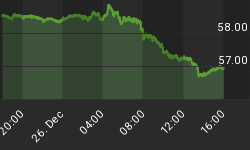In doing my stock chart overview in the past few weeks I've noticed a growing number of companies that pay increased dividends, including those who are paying them for the first time in years. This is really just a reflection of the corporate cash windfall of the past two years as stock prices have drastically recovered since bottoming in late 2002/early 2003 when the 12-year cycle bottomed. Fundamentally, you could say the cash recovery has also been aided by the Fed and its accommodative monetary policy and even by the Bush tax cuts and related corporate tax policy overhauls of the past year or so.
Whatever the reason, a trend of rising stock yields has historically been bullish. This being the infamous "fifth" year of the decennial pattern, stock prices tend to perform strongly (due mainly to the influence of the 10-year cycle that always bottoms at the end of the fourth year of the decade). We've discussed the year-ahead outlook and how this year may not witness a net gain for the year as measured by the S&P. But before the next major cycle peak this summer we should witness at least a couple of profitable broad market rallies that should push stock prices to higher highs, including some sectors that will continue momentum trends.
The Dow 30 index shows an impressive yield trend as we've discussed in previous commentaries. Slightly above the 3% level, the yield on the index reflects the rising yield in many of the Dow's blue-chip components as these companies have especially benefitted from the weak dollar and the commodity price bull market (not to mention overseas demand). There is also a well-known cycle of large-caps coming into favor among big money investors after the tech and small-cap sectors have had their run. This is attributable to the perceived safety of the bigger capitalized industries that pay dividends even as the economy slows down. In other words, investors take on a more defensive posture and turn to the perceived safety of yields in such environments following periods of rising commodity prices and imbalances in the financial markets and economy (due to war time spending or other factors).
Perhaps not coincidentally, while researching the yield trend recently I happened across an article in the latest newsletter by tax authority Dan Pilla (Dan Pilla's Confidential Tax Bulletin, 1015 Manning Dr., Fredericksburg, VA 22405). The article was entitled "Investors: Look for Stocks that Pay Dividends") and stated that since the Bush tax cut law of 2003, dividends are subject to much more favorable tax rates. It adds that Congress is also in the process of altering the tax code to mitigate against the double-taxation of corporate dividends.
This policy has encouraged companies to begin making dividend payments to shareholders, whereas in the past, corporate profits were rolled back into the company and reflected in higher stock prices, the article points out.
"Because of the favorable tax treatment on dividends, more companies are paying them," writes Pilla. "This is generating real income for investors and because of the lower tax rates, the payouts mean more disposable income for investors. And isn't that what investing is all about?"
Pilla asserts that now is the time to begin focusing on companies that are paying dividends, and I couldn't agree more. Pilla cites a report that found that since the tax law changes were implemented, the total annual dividends paid by S&P 500 companies is up about 23 percent in just one year, to about $179 billion.
In recent months I've found myself combing through the chart books paying more attention to the yield data than I do to other, more technical considerations (and this is coming from a die-hard technician!) The bottom line is that we should all begin paying more attention to those important yield trends in the individual stocks we're trading and investing in. The old Wall Street saying that it pays to invest in dividend-paying stocks definitely applies here in the current market environment. More on this topic in future commentaries...
















